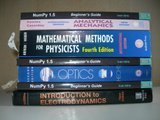4 Great Physics books I had to read
I made a list of four great introductory level Physics books I needed to read for my Master's degree. You can see them below.

1. Analytical Mechanics
Authors
Grant R. Fowles and George L. Cassiday
ISBN-10
0030989744
Mechanics was one of the first (if not the first) courses I followed in University. "Analytical Mechanics" is a brilliant junior level book that covers:
Newton's Laws of Motion
Harmonic motion
Kepler's Laws
Rigid bodies
Lagrangian Mechanics
The authors use real world examples such as falling raindrops to illustrate various concepts. The problems at the end of each chapter are quite challenging and interesting. There are also some numerical problems in the book, that should be solved with a computer. In my opinion there could have been more of those. The study group, that I was part of, ignored the "computer" problems completely.
2. Optics
Author
Eugene Hecht
ISBN-10
020111609X
I had a course on Optics in my first year in University with this book. The book has lots of examples and is very "wordy". I suspect the author hoped to make it a reference as well as a study book. The number of photos in "Optics" is unusually high for a Physics book. I wouldn't mind if some of those were colour photos, but then again it would have made the book less affordable. Topics include:
Mathematics of Waves
Light
Geometrical Optics
Polarization
Interference
Diffraction
Overall, I would say that this was a good book. Ideal for people who prefer long explanations.
3. Introduction to Electrodynamics
Author
David J. Griffiths
ISBN-10
013805326X
This book is an introduction on electricity and magnetism covering:
Electrostatics
Electric Fields
Magnetostatics
Magnetic Fields
Radiation
Relativistic Electrodynamics
The style of the book is very concise. In my opinion the majority of the examples are a bit abstract. Still the explanations are clear and the main points are indicated in such a way that you cannot miss them. For instance, in the story about Faraday's law, the sentence
"A changing magnetic field induces an electric field."
is printed in bold with a box around it and lots of whitespace. To be honest, I first tried winging it, only reading handouts and lecture notes. This was a big mistake. Having this book in my possession was a huge improvement.
4. Mathematical Methods for Physicists
Authors
George B. Arfken and Hans J. Weber
ISBN-10
0120598167
As far as I remember this book was required reading for the "Special Functions" course. You could argue that this is not a pure Physics book. However, it is certainly not a pure Mathematics book, since the examples are related to Physics problems:
Vector Analysis
Group Theory
Infinite Series
Complex Algebra
Special Functions
I think that this is an awesome book. Sometimes I just read it for fun. Seriously. I can't understand, how people can be so negative about it. Probably they were forced to go through the material at high speed without much help from their professors. I admit that this is not a good approach, especially given the size of the book.







